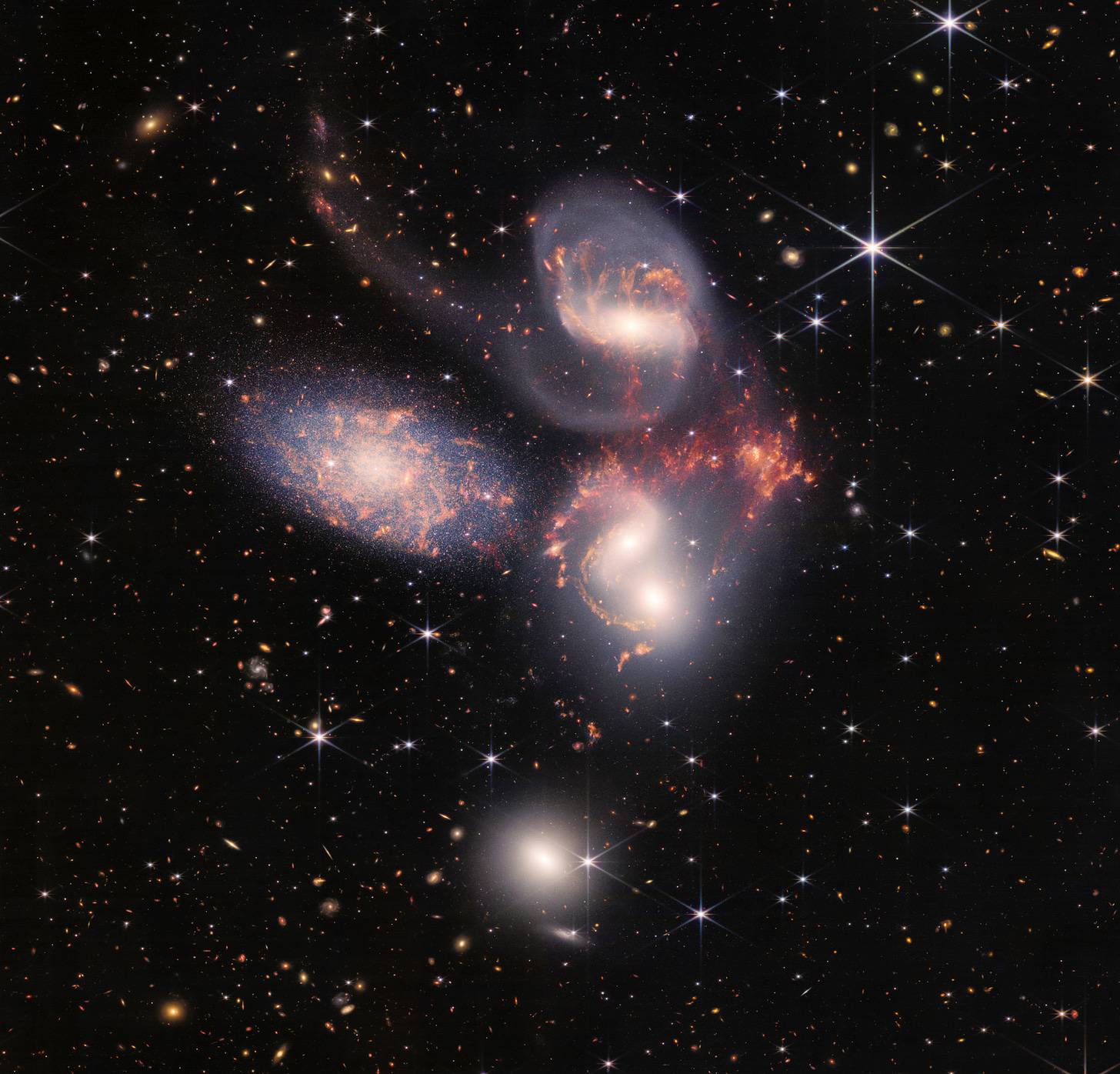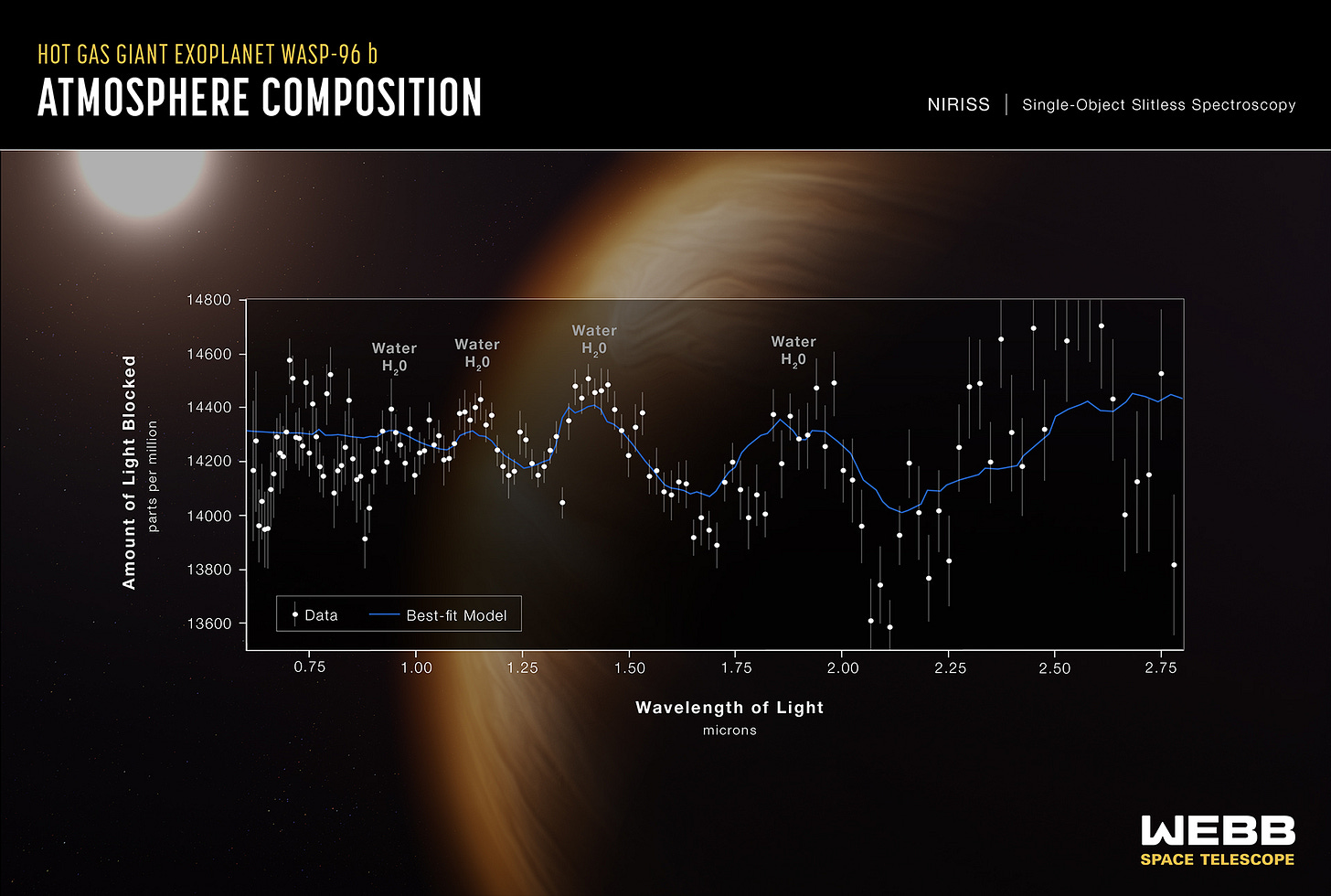Stephan’s Quintet: This image is actually a compilation of over 1000 separate JWST images, as it incorporates a size almost 1/5th of the Moon’s diameter. This cluster, first observed in 1877, located 290 million light years away includes 5 galaxies. Four of them are gravitational bound together and over cosmic time have numerous close encounters. In this image three of them in particular are seen to be shaped by these encounters, and regions of young stars bursting are clearly visible.
Southern Ring Nebula: Located 2500 light years away, these capture separate images of the clouds of gas and dust expelled in the last gasps of the death of a star. The gas has been traveling outward for thousands of years, producing the beautiful ring structure observed here.
WASP-96b: The spectrum of light absorbed by distant planet located over 1000 light years away which orbits its host star every 3.4 days. By analyzing the absorption of the host star’s light by the planetary atmosphere, one can search for molecules present in the atmosphere. In this case, clearly visible are the absorption lines of water. Future observations of exoplanets may reveal the presence of molecular signatures of life…
Carina Nebula: These ‘cosmic cliffs’ are actually the edge of a star forming region in the blue area, where intense UV light and stellar winds have emptied out the gas, which is piled up along these ‘cliffs’ about 7 light years high in some places.








Prof K,
I had to give a chalk talk lecture to the new trainees at the hospital yesterday on "Acute Kidney Injury" at noon Eastern, after I had just watched the live feed of the release of the new images from JWST from 10:30-11:30.
I told them the talk would be interactive and I would employ Socratic method in the hour. I started off, pulled up my pants, and said "first question...why am I wearing these space socks today?" Most looked at me with bewilderment, and were not aware of the glorious images from Webb. I pulled up the images for them. They found them "cool".
I proceeded with my interactive didactic session. They were very engaged, answered a lot of my questions, posed some good ones back at me. About 30 minutes in, we were discussing kinetics of serum creatinine rise after time of the insult/injury, and I was referring to time zero, and I slipped in a quick mention to the age of the universe being 13.8 billion years old (mostly in passing...I had a lot of concepts to cover about pathophysiology of kidney disease).
As I finish up around 1 PM, I ask "Any more questions?" (referring to acute kidney injury questions) and one of the new trainees says, "Yes, wait, how can there be a start of the universe? I thought it was eternal and constant?"
My eyes bulged! I was so excited that this question was brought up. I ran to my office, which fortunately was just across the hall from the conference room, and grabbed your book A Universe from Nothing. I held it up and said please read this book. I said I don't have time now, but the brief answer, that Prof Krauss will explain in the book, is that "Nothing" is unstable, and particles can pop in and out of existence, and these quantum fluctuations, 13.8 billions years ago, led to the massive creation of all the matter/anti-matter in the universe "for free". And this theory is supported by the fact, among others, as Krauss explains, that the total energy of the universe is zero. I also sent them a link to your lecture at the Radcliffe Institute in 2013: https://www.youtube.com/watch?v=vwzbU0bGOdc. I hope some of them become hooked on cosmology....will let you know!
This is so exciting and it’s just the beginning. I am looking so much forward to peak into the Dark Ages and who knows what else we be discovered.